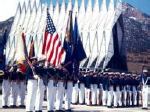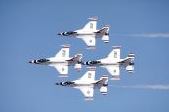





Historical Overview
Civil Air Patrol was founded Dec. 1, 1941. During World War II, its principal purpose was to allow private pilots and aviation enthusiasts to use their light aircraft and flying skills in civil defense efforts. In 1943, the organization came under control and direction of the Army Air Forces. Civil Air Patrol became a permanent peacetime institution July 1, 1946, when President Harry S. Truman signed Public Law 476 establishing it as a federally chartered, benevolent, civilian corporation. In May 1948, Public Law 557 made the organization the official auxiliary of the Air Force. This law, known as the CAP Supply Bill, authorized the secretary of the Air Force to assign military and civilian personnel to liaison offices at all levels of CAP.
The Civil Air Patrol performs three main functions -- aerospace education, cadet program and emergency services.
Aerospace Education
The Civil Air Patrol's aerospace education programs provide its membership, and the educational community, information about aviation and space activities. Each year it supports about 200 aerospace education workshops for teachers at 150 colleges and universities around the country, preparing approximately 7,000 teachers to teach aerospace-related subjects in their classrooms. The organization also develops curriculum and publishes aerospace educational materials for use in the nation's schools. Together with the National Aeronautics and Space Administration, and the Federal Aviation Administration, CAP co-sponsors the National Congress on Aviation and Space Education, the annual national convention for aerospace teachers.
Cadet Program
The purpose of Civil Air Patrol's Cadet Program is to inspire the country's youth to become leaders and good citizens through their interest in aerospace. It is open to U.S. citizens and legal residents of the United States, its territories and possessions. Candidates for the program must be between the ages of 12 and 18. The CAP Cadet Program offers an array of outstanding summer programs to include basic and advanced military training in leadership, drill, customs and courtesies. In addition, there are many nationally sponsored activities such as Air Education and Training Command Orientation Course, Space Command Orientation Course, Cadet Officer School, Hawk Mountain Search and Rescue School, Blue Beret National Encampment as well as glider and powered aircraft flight encampments which offer opportunities to solo in a glider or light airplane at low cost.
The CAP Cadet Program is designed to motivate and develop well-rounded young people, who in turn will become model citizens and the future leaders of our nation. CAP cadets progress at their own pace through a 15-step program including aerospace education, leadership training, physical fitness and moral leadership. Cadets can compete for academic scholarships to further their studies in such areas as engineering, science, aircraft mechanics and aerospace medicine. They can also compete for scholarships leading to solo flight training. Many outstanding cadets have an opportunity to go overseas in exchange programs with youth in other countries, and some of these exchange cadets even experience flying opportunities with foreign air forces.
Many of today's leaders, in and out of aviation, have benefited greatly from their experiences as Civil Air Patrol cadets. Each graduating class of the U.S. Air Force Academy is heavily populated with former CAP cadets--up to 10 percent in recent years. West Point and the U.S. Naval Academy also admit many CAP cadets each year. CAP cadets who enlist in the Air Force are immediately promoted two pay grades (to E-3) if they have completed the second phase of CAP cadet training. Cadets who choose to enlist in the Army, Navy, Marines or Coast Guard are immediately promoted one pay grade (to E-2) if they have completed the second phase of CAP cadet training.
1994 marked the introduction of the CAP Drug Demand Reduction Program (DDR). Targeted toward Active, Guard, and Reserve Air Force family members and members of the local community (typically within 30 miles of an Air Force installation), units participating in DDR actively perform the following activities:
In addition, CAP has made other major contributions to the counterdrug fight by providing aerial reconnaissance, airborne communications support, and airlift of law enforcement personnel. In 1995, CAP units flew nearly 32,000 hours in support of counterdrug efforts. As the official auxiliary of the U.S. Air Force, it's not surprising that Civil Air Patrol performs vital Air Force missions upon request. This support includes air search and rescue on USAF directed missions, light transport, communications support and low-altitude route surveys.
Emergency Services
Throughout the 1990s, CAP is still best known for its search and rescue mission. Civil Air Patrol air and ground teams perform 85 percent of inland search-and-rescue missions for the Air Force's Air Rescue Coordination Center. These volunteers donate their time and labor, receiving reimbursement for fuel and oil only, thus saving the taxpayers millions of dollars. More than 100 lives are saved every year by CAP members on search and rescue missions! CAP's disaster relief missions, such as those during hurricanes and floods, often don't make headlines, but CAP provides both air and ground transportation and an extensive communications network. CAP members also fly disaster relief officials to remote locations and support local, state and national disaster relief organizations with manpower and leadership. CAP ground teams provide vital assistance to disaster relief operations.
The CAP Emergency Communications Network spans the country with a data and voice net built to survive the loss of civil communications. With one of the most sophisticated communications networks in the nation, CAP supports local, state, and federal agencies during disaster relief, search and rescue and many other emergencies. The fleet of 530 CAP-owned aircraft communicates on CAP's own dedicated frequencies, while new systems coordinate and track search flights via sophisticated datalink.
Organizational Structure
Civil Air Patrol has eight geographic regions composed of 52 wings -- one wing for each state, Puerto Rico and the District of Columbia. Wings are subdivided into groups, squadrons and, sometimes, flights. There are approximately 1,700 individual units.
Headquarters Civil Air Patrol-United States Air Force and CAP National Headquarters are located at Maxwell Air Force Base, Ala. Additional CAP-USAF and CAP Corporate liaison personnel are assigned to CAP regions and wings to advise and assist field units. Air Force Reserve members also assist the Civil Air Patrol through the Reserve Assistance Program. In addition to personnel support, the Air Force provides equipment from Department of Defense excess items. Membership consists of over 19,000 cadets and 34,000 adult volunteers. They wear the Air Force uniform, but with distinctive CAP emblems and insignia. Members operate more than 5,000 privately owned aircraft and 530 CAP aircraft and more than 950 CAP vehicles in support of the organization's programs.
Bottom Line
Civil Air Patrol offers training opportunities comparable to JrROTC while simultaneously supporting real world emergency services and civil defense missions. CAP participation can be an advantage in competing for a USAFA appointment. Note, in the USAFA class of 2003, 11% had JrROTC, and 7% had CAP.